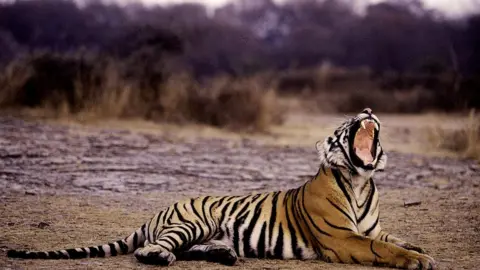Elephant and tiger attacks highlight India's wildlife conflict
 Chester Zoo / Assam Haathi Project.
Chester Zoo / Assam Haathi Project. Members of the Paharia tribe living in the upper hill regions of India's Jharkhand state have been spending sleepless nights.
A marauding elephant has trampled at least 15 local people to death in the past few months.
Further north, villagers living around the Pilibhit Tiger reserve in Uttar Pradesh are up in arms after three people were killed by a tiger within a week. At least 16 people have been killed in tiger attacks near the reserve since last October.
"We have sent in teams to tranquilise the animal and relocate it inside the reserve," said VK Singh, a senior Uttar Pradesh forest department official. "We understand that people are also afraid. It is challenging."
There are similar stories in southern and eastern India where animal sanctuaries are located. It is not just forested areas that are affected - even people in suburban areas and small towns have started encountering animals like leopards.
According to the Indian environment ministry, 1,144 people were killed in elephant and tiger attacks between April 2014 and May 2017. Experts say the numbers could be much higher if attacks by leopards and other wild animals were included in the list.
"Human-animal conflict is one of the biggest challenges for conservation efforts - especially for large species which get lots of attention," said Alexandra Zimmermann, chair of the International Union for Conservation of Nature's (IUCN) Task Force on Human-Wildlife conflict.
After an alarming fall in the number of tigers, the Indian government launched the Project Tiger initiative in the 1970s. Protected zones were declared, new animal reserves were announced and anti-poaching measures implemented. As a result, the numbers have gone up.
Two-thirds of the world's tigers live in India, with their numbers increasing from about 1,700 to more than 2,200 in the last five years.
K Ullas Karanth, director for Science-Asia at the Wildlife Conservation Society, says increased human-animal conflict must be viewed as a result of the success of conservation in India.
"This problem is restricted to parts of India where parks have recovered and wildlife has increased, in the case of some species like tigers," he said.
I visited Sathyamangalam Tiger reserve in Tamil Nadu earlier this year. This forest area was not known for tigers, and was only declared a tiger reserve in 2013. About 25 tigers are thought to be living in the area and the population is increasing.
Experts believe that the tigers in the new reserve may have migrated from the neighbouring state of Karnataka due to over-population in sanctuaries there.
Villagers in the area say they are increasingly seeing tigers very close to houses, roads and rivers. There have been several elephant attacks in the area but people now are worried about tigers too.
 AFP
AFPNearly 60% of Asia's elephants live in India, where their estimated population is between 24,000 and 32,000. But elephants are thought to kill about 500 people each year, far more than any other wild animal.
Experts say expanding human populations have cut off elephant corridors, trapping the animals in smaller areas and forcing them to raid towns and villages.
"Elephants do move along traditional routes and we have some understanding of what those corridors are," says Ms Zimmermann, who is also the head of Conservation Science at Chester Zoo in the UK. "But they can adapt as any other intelligent species."
She says more thought is needed on how elephant corridors can be protected and training given to villagers so the animals can move through safely.
Striking a balance
India has 1.2 billion people and the population is growing, putting immense pressure on land to build homes and factories.
"As we try to meet this aspiration for economic growth, we do have to have careful evaluation of projects," says Mr Karanath.
"And the government is not doing that. They are rushing through projects, sometimes without proper safeguards built. This is a matter of serious concern."
Conservation work has had some success in increasing wild animal populations. The task now is to strike a balance in the competition for land between people and animals.
But there is little comfort for those caught in the middle.
"We want the forest officials to kill the tiger responsible for the attacks," a relative of a farmer killed near the Pilibhit reserve told local media. "This is our only demand. We won't settle for anything less than that."
